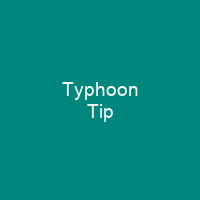Typhoon Tip, known in the Philippines as Typhoon Warling, was the largest and most intense tropical cyclone ever recorded. Tip developed out of a disturbance within the monsoon trough on October 4 near Pohnpei in Micronesia. After passing Guam, Tip rapidly intensified and reached peak sustained winds of 305 kmh and a worldwide record-low sea-level pressure of 870 hPa. It made landfall in southern Japan on October 19, and became an extratropical cyclone shortly thereafter.
About Typhoon Tip in brief
 Typhoon Tip, known in the Philippines as Typhoon Warling, was the largest and most intense tropical cyclone ever recorded. Tip developed out of a disturbance within the monsoon trough on October 4 near Pohnpei in Micronesia. After passing Guam, Tip rapidly intensified and reached peak sustained winds of 305 kmh and a worldwide record-low sea-level pressure of 870 hPa. Tip slowly weakened as it continued west-northwestward and later turned to the northeast, in response to an approaching trough. The typhoon made landfall in southern Japan on October 19, and became an extratropical cyclone shortly thereafter. Tip’s remnants continued moving east-northeastward, until they dissipated near the Aleutian Islands on October 24. U.S. Air Force aircraft flew 60 weather reconnaissance missions into the typhoon, making Tip one of the most closely observed tropical cyclones. Rainfall from Tip indirectly led to a fire that killed 13 Marines and injured 68 at Combined Arms Training Center, Camp Fuji in the Shizuoka Prefecture of Japan.
Typhoon Tip, known in the Philippines as Typhoon Warling, was the largest and most intense tropical cyclone ever recorded. Tip developed out of a disturbance within the monsoon trough on October 4 near Pohnpei in Micronesia. After passing Guam, Tip rapidly intensified and reached peak sustained winds of 305 kmh and a worldwide record-low sea-level pressure of 870 hPa. Tip slowly weakened as it continued west-northwestward and later turned to the northeast, in response to an approaching trough. The typhoon made landfall in southern Japan on October 19, and became an extratropical cyclone shortly thereafter. Tip’s remnants continued moving east-northeastward, until they dissipated near the Aleutian Islands on October 24. U.S. Air Force aircraft flew 60 weather reconnaissance missions into the typhoon, making Tip one of the most closely observed tropical cyclones. Rainfall from Tip indirectly led to a fire that killed 13 Marines and injured 68 at Combined Arms Training Center, Camp Fuji in the Shizuoka Prefecture of Japan.
Elsewhere in the country, the Typhoon caused widespread flooding and 42 deaths; offshore shipwrecks left 44 people killed or missing. Tip was the forty-third tropical depression, nineteenth tropical storm, twelfth typhoon and third super typhoon of the 1979 Pacific typhoon season. It was the last typhoon to make landfall in the Pacific Ocean before the end of the season. At its peak strength, Tip had a wind diameter of 2,220 km, making it the largest tropicalcyclone on record. Tip continued to intensify further, becoming a Category 5-equivalent super Typhoon, and early on October 12, a reconnaissance aircraft recorded a worldwide-low pressure of 870 mbar with 1-minute sustained winds. At the time of its peak, its eye was 15km wide, prompting the PAGASAS agency to list Tip as peaking at 135th meridian east.
You want to know more about Typhoon Tip?
This page is based on the article Typhoon Tip published in Wikipedia (as of Dec. 05, 2020) and was automatically summarized using artificial intelligence.







